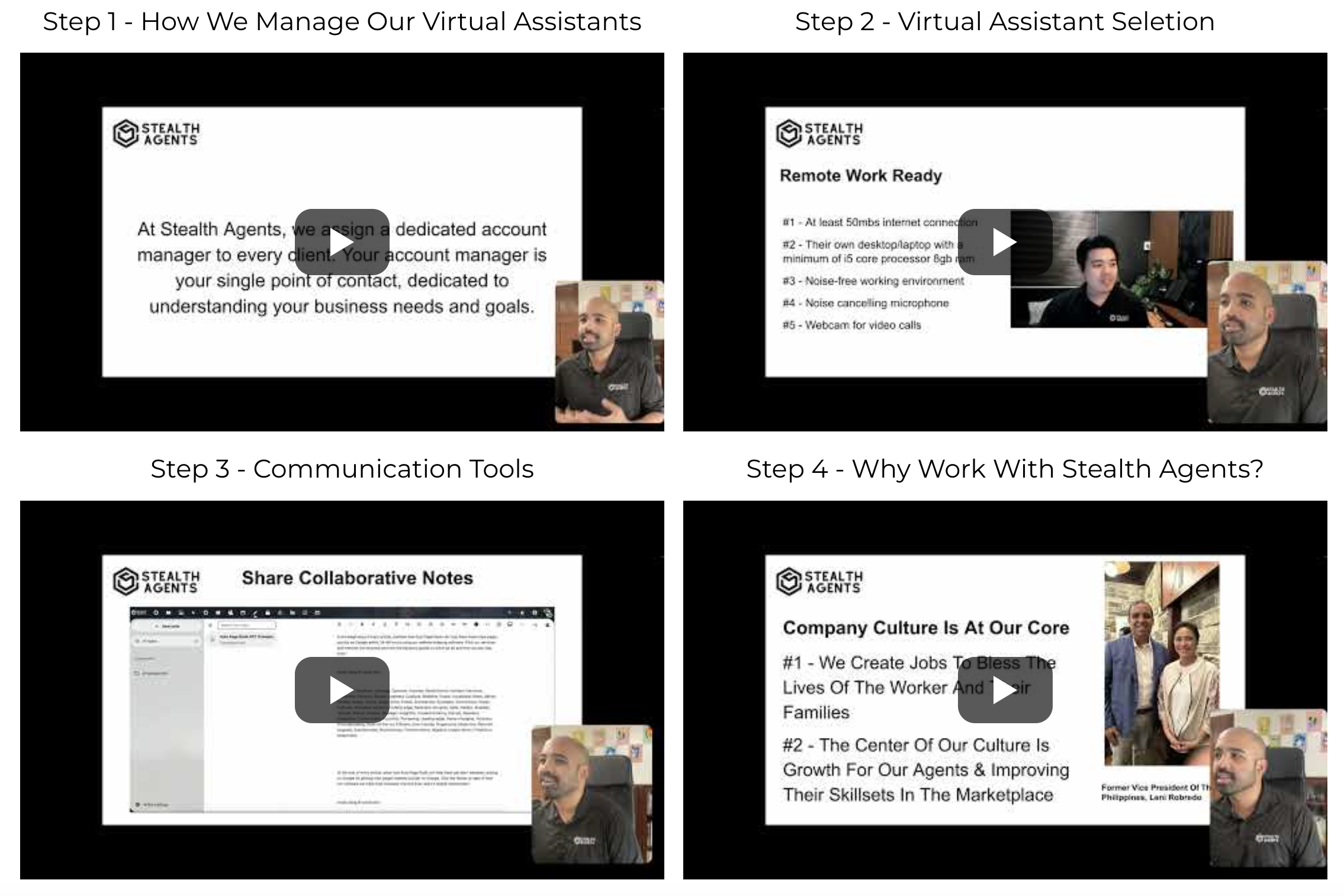When choosing the right communication tool is essential for enhancing productivity and collaboration.
Slack vs Quip are two popular platforms that serve distinct purposes.
Slack excels in real-time messaging, offering channels and integrations that streamline team communication.
Conversely, Quip is ideal for document collaboration and allows teams to collaborate seamlessly on spreadsheets and documents.
For businesses utilizing virtual assistant services, understanding these tools can optimize workflow and align with specific needs, such as managing tasks efficiently and setting competitive virtual assistant pricing.
By examining Slack and Quip’s strengths, organizations can make informed decisions about how to effectively support their virtual assistants.
This insightful resource has been thoughtfully created and curated by Stealth Agents to guide you in making the best choice for your business.
What is Quip?
Quip is a collaborative productivity tool designed to enhance teamwork by integrating documents, spreadsheets, and chat in one seamless platform.
It allows users to work together in real-time, making edits and updates instantly visible to everyone involved.
Quip’s intuitive interface simplifies creating and sharing content, making it ideal for small teams and large organizations.
By blending communication and collaboration, Quip fosters an environment where ideas will flourish and projects can progress without the hassle of switching between multiple tools.
This versatility makes Quip a valuable asset for improving efficiency and streamlining workflows.
Key Features:
- Real-Time Collaboration: Quip allows many users to edit documents simultaneously, ensures that everybody are minimizing the chance of version disputes and keeping everyone in sync.
- Integrated Chat: Built-in chat functionality enables team members to discuss projects and documents simultaneously, enhancing communication and collaboration.
- Mobile Accessibility: Utilizing Quip’s mobile apps for iOS and Android ensures that team members can stay connected and productive on the go.
- Task Management: Quip includes task assignment and tracking features, allowing teams to organize their workflow and prioritize tasks effectively.
- Document Sharing: Easily share documents with team members or external partners to ensure that everyonee can access to the latest information and updates.
Pros:
- User-Friendly Interface: Quip’s user-friendly design facilitates effortless navigation and feature utilization without a steep learning curve, promoting quick adoption.
- Seamless Integration: Quip integrates with various third-party applications, allowing teams to connect their existing tools and streamline workflow.
- Robust Collaboration Tools: The platform’s emphasis on real-time collaboration and communication helps teams work more effectively and make decisions faster.
- Flexibility Across Devices: Quip provides consistent functionality across desktop and mobile devices, ensuring productivity is not limited to the office.
- Robust Security Measures: Quip prioritizes data security with encryption and access controls, providing peace of mind for businesses handling sensitive information.
Cons:
- Limited Advanced Features: While Quip excels at basic collaboration, it may lack some advanced features required by larger enterprises or specific industries.
- Dependence on Internet Connection: Quip requires a stable internet connection for full functionality as a cloud-based tool, but there is a limitation in areas with poor connectivity.
- Subscription Costs: Quip’s pricing model may be a barrier for smaller teams or startups looking to keep costs low despite the value it offers.
- Learning Curve for Complex Tasks: Although Quip is user-friendly for basic use, mastering all of its capabilities can take time, especially for users new to collaborative tools.
- Integration Challenges: While Quip integrates with many apps, occasional compatibility issues can require technical adjustments or workarounds.
What is Slack?
Slack is the communication platform known to facilitate seamless team collaboration and communication through real-time messaging.
It integrates various tools and services, making it a versatile hub for workplace interactions.
With organized channels, users can keep conversations focused and relevant, enhancing productivity.
Slack also supports file sharing and direct messaging, ensuring all communication needs are met within one platform.
Its intuitive interface and powerful features make it an indispensable tool for today’s businesses seeking efficient teamwork.
Key Features:
- Real-time Messaging: Slack facilitates instant communication with team members, enabling quick decision-making and problem-solving.
- Organized Channels: Users can create channels for specific projects or topics, ensuring that discussions remain focused and information is easily retrieved.
- Integrations: Slack supports many integrations with other tools, enhancing functionality and allowing seamless workflow management.
- File Sharing: Easily share documents and media within conversations, ensuring all necessary resources are accessible in one place.
- Searchable History: Slack archives messages, making searching and retrieving past discussions or shared files simple.
Pros:
- Enhanced Productivity: Slack streamlines communication, reducing the time spent on emails and meetings, which boosts team efficiency.
- User-friendly Interface: Its intuitive design ensures it is easy to navigate and utilize, and all available features are user-friendly without a steep learning curve.
- Customizable Notifications: Users can tailor notifications to their preferences, ensuring they stay informed without becoming overwhelmed.
- Mobile Accessibility: Slack’s mobile app allows users to be connected and collaborate on the go, ensuring productivity isn’t limited to the office.
- Community Support: A vast community of users provides ample resources, tips, and support for troubleshooting and maximizing Slack’s capabilities.
Cons:
- Information Overload: With numerous channels and messages, users may experience notification fatigue, making it challenging to prioritize information.
- Limited Video Conferencing: Slack offers video call capabilities but may not be as robust as dedicated conferencing tools for larger meetings.
- Cost Considerations: Premium features and integrations can be pricy for small businesses or startups with limited budgets.
- Security Concerns: Like different digital platforms, data security is a concern, requiring businesses to implement additional safeguards.
- Dependency on the Internet: Slack relies on a stable Internet connection, meaning any disruptions can impact communication and productivity.
Slack vs Quip: Detailed Features Comparison
1. Communication Style
In comparing Slack vs Quip, a key distinction emerges in their communication methodologies.
Slack excels by following guidelines for effective communication assistant.
It offers real-time messaging that keeps team members promptly connected and informed.
Its organized channels streamline discussions by topic, ensuring communication remains focused and efficient.
Conversely, Quip centers on document-centric collaboration, enabling users to discuss edits and updates directly within shared documents and spreadsheets.
For those seeking guidance from a Filipino communication specialist, Slack is ideal for dynamic interactions, whereas Quip is suited for structured, document-based discussions.
2. Integration Capabilities
In the productivity vs. hours worked discussion, the Slack vs Quip debate highlights a pivotal aspect: tool integration.
Slack excels with its vast array of integrations, allowing seamless connections with various apps and services that boost workflow management.
This adaptability enables businesses to customize Slack to meet specific operational requirements, incorporating notifications and data from numerous external sources.
Quip, although it provides integrations, primarily enhances document collaboration with a focus on productivity tools and databases.
Thus, Slack is ideal for teams needing a comprehensive communication hub, while Quip is better suited for efficient document management.
3. User Interface and Accessibility
The user interface is a critical consideration when comparing Slack vs Quip.
Slack’s interface is designed for ease of communication, with intuitive navigation that supports fast-paced, interactive exchanges.
Users appreciate the customizable notifications and mobile app, which ensure they stay connected anywhere.
Quip offers a clean, document-focused interface that facilitates easy editing and collaboration.
Its design is optimal for teams that require a seamless way to manage and annotate documents in a shared workspace, presenting a straightforward approach to document handling.
4. File Sharing and Collaboration
File sharing is a crucial area where the best productivity apps for remote collaboration, like Slack vs Quip, show distinct differences.
Slack enables users to attach files within conversations, ensuring resources are easily accessible during discussions.
However, its primary function is as a communication tool rather than a file management system.
On the other hand, Quip is designed for document collaboration, allowing users to create, share, and edit documents and spreadsheets effortlessly.
This makes Quip an excellent choice for teams that rely heavily on interactive document usage, while Slack caters to general communication needs.
5. Pricing and Value
When considering Slack vs Quip, pricing is an important aspect influencing user choice.
Slack offers a freemium model with tiered premium options, accommodating different business sizes and needs, though some advanced features may incur additional costs.
Quip also provides a tiered pricing structure, often bundled with Salesforce, which can benefit businesses using CRM solutions.
The decision between Slack and Quip usually depends on the features and integrations that deliver the most value to a company, alongside budget considerations.
How Stealth Agents Choose Slack vs Quip?
At Stealth Agents, the decision between Slack and Quip is guided by a thorough assessment of team collaboration needs and operational goals.
Understanding each platform’s distinct capabilities, the choice hinges on evaluating communication styles and the nature of project workflows.
Slack’s real-time messaging and channel organization strength are ideal for teams requiring dynamic and immediate interactions.
In contrast, Quip’s document-centric approach suits projects where structured, in-document collaboration is pivotal.
Integration possibilities also play a crucial role, as Slack’s extensive connectivity with various tools supports complex workflows, while Quip’s focus on productivity tools enhances document management.
Additionally, the intuitive user interfaces and how they align with team preferences are essential factors.
Ultimately, pricing and each platform’s value to productivity drive the final decision, ensuring the chosen tool aligns perfectly with Stealth Agents’ strategic objectives.
Conclusion
Each platform showcases unique strengths tailored to different collaboration needs in the Slack vs Quip debate.
Slack facilitates real-time communication and dynamic interactions, making it ideal for teams that thrive on immediate connectivity and organized discussions.
Conversely, Quip shines in document collaboration, providing a seamless environment for creating, sharing, and editing documents where structured teamwork is crucial.
Choosing between Slack vs Quip depends on your team’s specific requirements, whether they’re focused on communication or document management.
Ultimately, understanding the distinct advantages of each tool allows businesses to select the one that best enhances their productivity and collaboration efforts.












